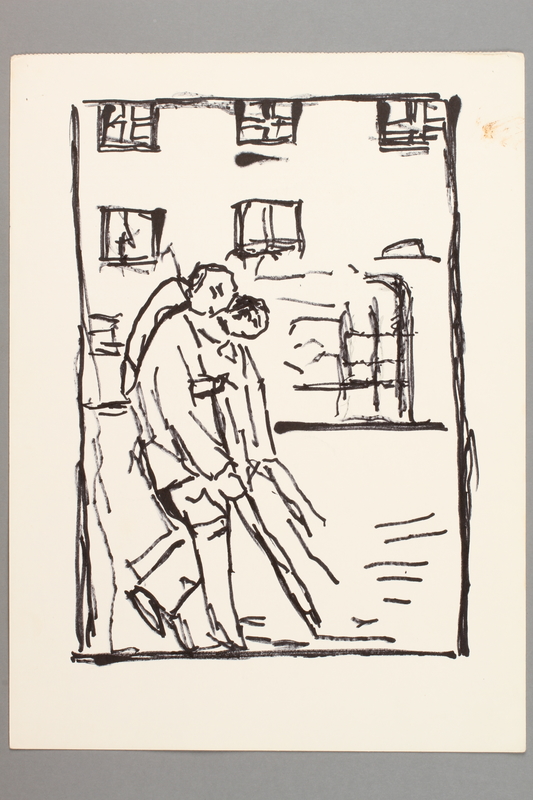Overview
- Brief Narrative
- One of a portfolio of drawings by Leibel and Ilie, along with the original sketches by Dr. Arthur Kessler. Dr. Kessler commissioned the drawings based on his sketches.
- Credit Line
- United States Holocaust Memorial Museum Collection, Gift of David Kessler
Physical Details
- Classification
-
Art
- Category
-
Drawings
- Object Type
-
Drawing (lcsh)
- Dimensions
- overall: Height: 9.630 inches (24.46 cm) | Width: 13.000 inches (33.02 cm)
- Materials
- overall : paper, ink
Rights & Restrictions
- Conditions on Access
- No restrictions on access
- Conditions on Use
- No restrictions on use
Administrative Notes
- Legal Status
- Permanent Collection
- Provenance
- The drawing was donated to the United States Holocaust Memorial Museum in 2019 by David Kessler, the son of Arthur Kessler.
- Record last modified:
- 2022-08-15 07:37:16
- This page:
- https://collections.ushmm.org/search/catalog/irn707024
Download & Licensing
In-Person Research
- By Appointment
- Request 21 Days in Advance of Visit
- Plan a Research Visit
- Request to See This Object
Contact Us
Also in Dr. Arthur Kessler collection
The collection documents the Holocaust experiences of Dr. Arthur Kessler, originally of Czernowitz (Chernivtsi, Ukraine), including his imprisonment in the Vapniarka concentration camp in Transnistria and his efforts to treat and manage an outbreak of paralysis of fellow prisoners due to consumption of Lathyrus sativus. Included are artifacts, objects gifted to him, biographical materials, correspondence, research notes and samples related to Lathyrism, written testimony, writings, and a small amount of photographs. Also included is his unpublished memoir Ein Arzt im Lager (A Camp Physician).
Date: 1890-1982
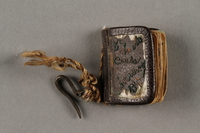
Miniature book of sketches made by camp prisoners for Dr. Arthur Kessler
Object
Miniature, handmade sketchbook of ink and watercolor sketches created by several prisoners in Vapniarka concentration camp and gifted to Dr. Arthur Kessler in 1943. The images depict scenes of daily prisoner life in the concentration camp. Dr. Kessler was a fellow inmate, and was given “The Little Book” by the prisoners, many of whom he treated while managing a 30-person medical department at the camp. In late 1942, he treated fellow prisoners who had gone on a hunger strike because of their reactions, including paralysis, to eating a toxic fodder pea, Lathyrus sativus. Following the war, Dr. Kessler gave lectures and published articles about these reactions, and was considered a leader in the field of Lathyrism. He also continued to treat the victims of Vapniarka who survived and immigrated to Israel without compensation.
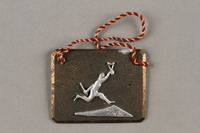
Metal plaque made by Vapniarka prisoners
Object
Handmade metal plaque with yarn loop for hanging, given as gift to Dr. Arthur Kessler, who was interned and worked at Vapniarka concentration camp in Transnistria. The plaque was made and given to him by prisoners at Vapniarka.
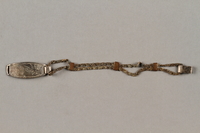
Bracelet made by Vapniarka prisoners
Object
Metal bracelet given as gift to Dr. Arthur Kessler, who was interned and worked at Vapniarka concentration camp in Transnistria. The bracelet was made and given to him by prisoners at Vapniarka.
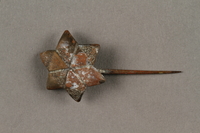
Pin made by Vapniarka prisoners
Object
Pin given as gift to Dr. Arthur Kessler, who was interned and worked at Vapniarka concentration camp in Transnistria. The pin was made and given to him by prisoners at Vapniarka.
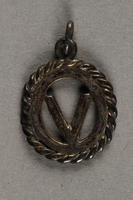
"V" pendant or charm, made by Vapniarka prisoners
Object
Pendant or charm with the letter "V" given as gift to Dr. Arthur Kessler, who was interned and worked at Vapniarka concentration camp in Transnistria. The pendant was made and given to him by prisoners at Vapniarka.
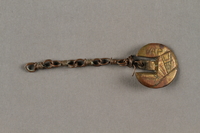
Chain with pendant or charm, made by Vapniarka prisoners
Object
Chain with pendant or charm given as gift to Dr. Arthur Kessler, who was interned and worked at Vapniarka concentration camp in Transnistria. The pendant was made and given to him by prisoners at Vapniarka.
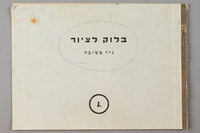
Portfolio cover for series of drawings and sketches
Object
Portfolio of drawings by Leibel and Ilie, along with the original sketches by Dr. Arthur Kessler. Dr. Kessler commissioned the drawings based on his sketches.
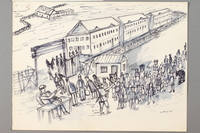
Drawing with original sketch
Object
One of a portfolio of drawings by Leibel and Ilie, along with the original sketches by Dr. Arthur Kessler. Dr. Kessler commissioned the drawings based on his sketches.
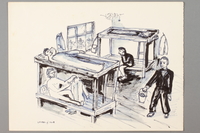
Drawing with original sketch
Object
One of a portfolio of drawings by Leibel and Ilie, along with the original sketches by Dr. Arthur Kessler. Dr. Kessler commissioned the drawings based on his sketches.

Drawing with original sketch
Object
One of a portfolio of drawings by Leibel and Ilie, along with the original sketches by Dr. Arthur Kessler. Dr. Kessler commissioned the drawings based on his sketches.
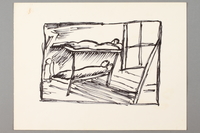
Drawing with original sketch
Object
One of a portfolio of drawings by Leibel and Ilie, along with the original sketches by Dr. Arthur Kessler. Dr. Kessler commissioned the drawings based on his sketches.
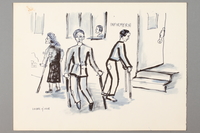
Drawing with original sketch
Object
One of a portfolio of drawings by Leibel and Ilie, along with the original sketches by Dr. Arthur Kessler. Dr. Kessler commissioned the drawings based on his sketches.

Drawing with original sketch
Object
One of a portfolio of drawings by Leibel and Ilie, along with the original sketches by Dr. Arthur Kessler. Dr. Kessler commissioned the drawings based on his sketches.
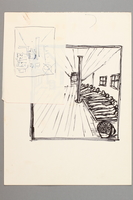
Drawing with original sketch
Object
One of a portfolio of drawings by Leibel and Ilie, along with the original sketches by Dr. Arthur Kessler. Dr. Kessler commissioned the drawings based on his sketches.
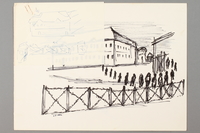
Drawing with original sketch
Object
One of a portfolio of drawings by Leibel and Ilie, along with the original sketches by Dr. Arthur Kessler. Dr. Kessler commissioned the drawings based on his sketches.
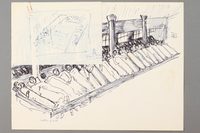
Drawing with original sketch
Object
One of a portfolio of drawings by Leibel and Ilie, along with the original sketches by Dr. Arthur Kessler. Dr. Kessler commissioned the drawings based on his sketches.
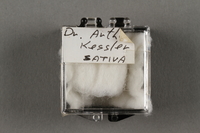
Sativa or fodder pea seed
Object
Fodder pea (sativa) seed collected by Dr. Arthur Kessler at Vapniarka camp in Transnistria, where he worked and was interned.
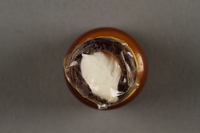
Seed housed inside glass jar
Object
Seed, possibly fodder pea (sativa), collected by Dr. Arthur Kessler at Vapniarka camp in Transnistria, where he worked and was interned.
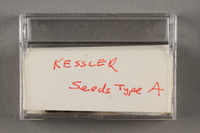
Seeds "Type A"
Object
Seeds collected by Dr. Arthur Kessler at Vapniarka camp in Transnistria, where he worked and was interned.
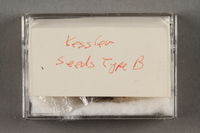
Seeds "Type B"
Object
Seeds collected by Dr. Arthur Kessler at Vapniarka camp in Transnistria, where he worked and was interned.
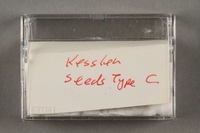
Seeds "Type C"
Object
Seeds collected by Dr. Arthur Kessler at Vapniarka camp in Transnistria, where he worked and was interned.
Charms made by Vapniarka prisoners
Object
Handmade charms given as gift to Dr. Arthur Kessler, who was interned and worked at Vapniarka concentration camp in Transnistria. The charms (a handmade metal bucket and crutch on a fabric chain, plus an additional crutch), were made and given to him by prisoners at Vapniarka.
Dr. Arthur Kessler papers
Document
The collection documents the Holocaust experiences of Dr. Arthur Kessler, originally of Czernowitz (Chernivtsi, Ukraine), including his imprisonment in the Vapniarka concentration camp in Transnistria and his efforts to treat and manage an outbreak of paralysis of fellow prisoners due to consumption of Lathyrus sativus. Included are biographical materials, correspondence, research notes on Lathyrism, written testimony, writings, and a small amount of photographs. Also included is his unpublished memoir Ein Arzt im Lager (A Camp Physician). Biographical materials include birth certificates, a marriage certificate, identification cards, Romanian passports, restitution claims paperwork for Arthur and his wife Chaia, and papers related to Arthur’s medical career. Also included is a document regarding Arthur’s release from jail in Czernowitz in 1942 and an exemption certificate from deportation from Czernowitz in 1942. Correspondence primarily consists of wartime letters written to his cousin Jacob Granirer in Bucharest, possibly regarding his work with Lathyrism in Vapniarka. There is also a 1946 letter to Arthur from the Bezalel National Museum regarding the exhibition of gifts given to him by fellow prisoners of Vapniarka. Vapniarka related documents include a list of survivors of the camp living in Israel, notebooks and loose notes regarding Arthur’s work with Lathyrism while in Vapniarka, typed testimony in German about his experiences there that was likely submitted to Yad Vashem, and restitution claims paperwork for survivors of Vapniarka. Writings consist of articles written by Arthur regarding Lathyrism as well as his unpublished memoir. The articles include a 1963 article in German and an English translation entitled “Vascular diseases by consumption of Lathyrus Sativa” that was never published. Arthur’s unpublished memoir, Ein Arzt im Lager (A Camp Physician) was likely written in the 1960s. In it, he describes his arrest and deportation to Vapniarka, his involvement and observations about the disease afflicting the prisoners, the experiences of Arthur and other prisoners transferred from Vapniarka to the Olgopol ghetto (Olhopil, Ukraine), his return to Romania, reunification with his family, and flight from Romania. The manuscript is typed in German with some handwritten edits. It is split into three chapters: I. Im Lager, II. Im Ghetto, and III. Der Weg Zurück. Chapter II contains some hand illustrations and there are two hand drawn maps after Chapter III. Photographs consist of pre-war, wartime, and postwar depictions of Arthur and his family. Included is a photograph of Arthur’s parents, Anna and David Kessler; depictions Arthur as a doctor in the Romanian army and in Zwickau, Germany, a 1943 photograph of Arthur in Olgopol with Dr. Moritz, Polia, Dubs, and three other unknown individuals, and an undated photograph with Arthur, Polia Dubs, “Engineer Berkovitz,” Dr. Moritz, and “Engineer Davidovitz.” There are also four post-war photographs of an exhibit on Vapniarka at the Ghetto Fighters’ House in Israel.

